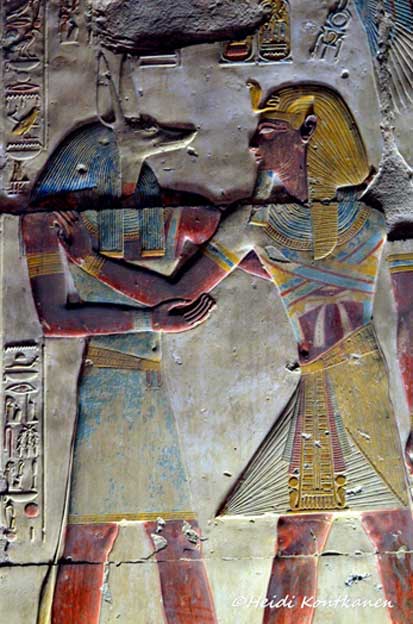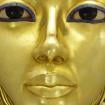Wepwawet, Lord of Abydos and Champion of Royalty: Jubilees, Worship and Resurrection—Part II
From being a god with militaristic overtones, in time, Wepwawet was hailed as the ‘Lord of the Necropolis’, a role he acquired from Osiris, at his cult centers in Abydos and later Asyut too. A complex deity, Wepwawet catered to different needs – such as protection of the pharaoh, a participant in the ‘Opening of the Mouth’ ceremony; as the ‘Opener of the Ways’ in the Duat (Netherworld); ‘Opener of the Womb’ as the first-born and so on. Along with Anubis, his father (or sibling), the deity ensured the all-round wellness of king and commoner alike – both here on earth and in the Afterlife.

This relief shows Wepwawet embracing Seti I as the King journeys to the Next World; the vulture goddess Nekhbet hovers above protectively (top right). The scene is found on the western wall of the Second Hypostyle Hall; between the chapels of Isis and Osiris. Mortuary Temple of Seti I, Abydos.
Discerning the Necropolis God
On May 30, 1926 renowned British Egyptologist, Howard Carter, who created history by discovering the treasure-filled tomb of the boy king Tutankhamun, made a curious entry in his diary. He noted the sighting of a couple of strange-looking animals. Carter wasn’t sure if one of them was a jackal or a wolf: “In the hills behind my house at Elwat e’diban, Western Thebes, I saw a pair of jackals about 6pm making their way towards the cultivated land. They probably had cubs in the hills as otherwise it was early for them to descend to inhabited and cultivated quarters. But the great interest was, while one of them was of normal size and coloring, the other - I was unable to tell whether dog or bitch, as they did not approach nearer than 250 yards (228 meters) - was totally black, much taller and attenuated, resembling, though tail not quite so bushy, the type ‘ inpw’ as found upon the monuments. This is the first example of that coloring and of that kind of jackal I have seen in Egypt for over 35 years’ experience in the desert, and it suggested to me, unless the black jackal is known, a spot of the old and original Egyptian jackal only now known to us as Anubis.’
Like this Preview and want to read on? You can! JOIN US THERE ( with easy, instant access ) and see what you’re missing!! All Premium articles are available in full, with immediate access.
For the price of a cup of coffee, you get this and all the other great benefits at Ancient Origins Premium. And - each time you support AO Premium, you support independent thought and writing.
Independent researcher and playwright Anand Balaji is an Ancient Origins guest writer and author of Sands of Amarna: End of Akhenaten.
[The author thanks Merja Attia, Heidi Kontkanen and Hossam Abbas for granting permission to use their photographs. The public archives of the Metropolitan Museum of Art can be accessed here.]
Top image: Bronze statuette of the funerary deity, Wepwawet; design by Anand Balaji (Photo credit: Brooklyn Museum); Deriv.
By Anand Balaji




















